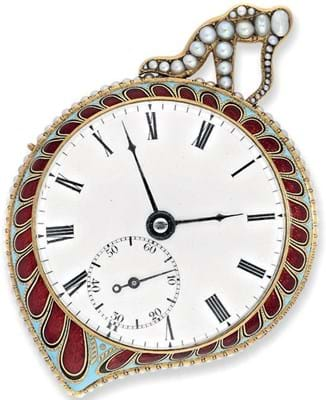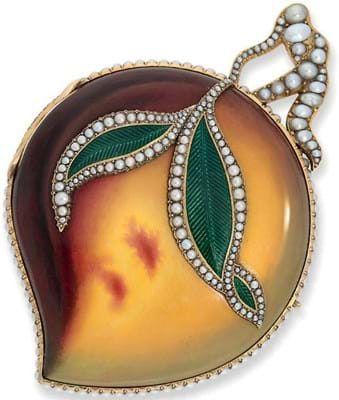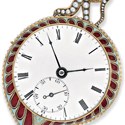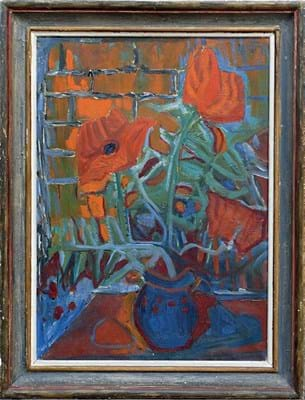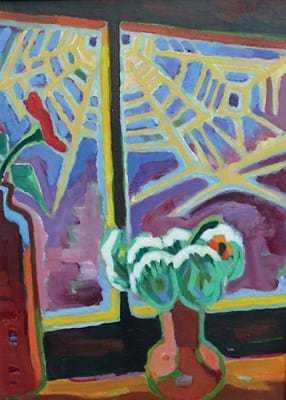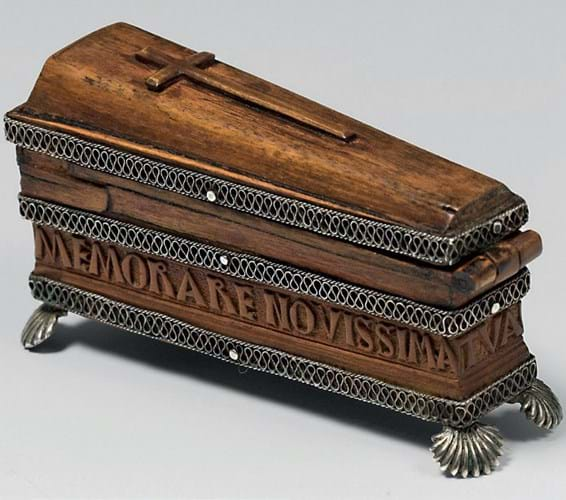A prime example of his craftsmanship came up for sale at Cortrie (20% buyer’s premium) in Hamburg on September 15. It was a watch with a duplex escapement in the form of a peach or a mango from about 1810, numbered 6577.
As was customary, the movement was richly engraved and fitted with eye-catching blued-steel parts. Watches of this kind were generally sold as pairs, which was not only a good marketing ploy, but also fitted in well with the Chinese idea of harmony and balance.
Of the eight previously known examples of Ilbery’s peach or mango watch, six are mirror image pairs – an individual watch was sold in Frankfurt in 2016. The latter is almost identical to the one sold in Hamburg, but was not consecutively numbered and was fitted with a central seconds hand whereas the Hamburg watch has a small subsidiary seconds dial.
The rarity was not lost on the seven international bidders on the phones and in the room, who pushed the price to €190,000 (£168,140), with a private collector claiming his prize.
Expressive German works
Geble (19% buyer’s premium) in Radolfzell achieved notable prices for two post-war works by German Expressionists from a south German private collection in a sale on October 20.
Roter Mohn in blauem Krug (Red Poppies in Blue Pitcher), a 2ft 4in x 20in (72 x 51cm) oil painting by Otto Dix from 1948, was in its original painted frame. It sold to a German collector for €60,000 (£53,100), going above the guide of €45,000.
Dix was primarily known for his radical depictions of the horrors of the First World War and his often unflattering portraits from the 1920s. After the Second World War he devoted himself to floral still-lifes, portraits of children and re-interpretations of Flemish Old Master paintings. Also at Geble, a well-documented work was Karl Schmidt-Rottluff’s (1884-1976) Spinnennetz am Fenster (Cobweb at the Window), a 2ft 11in x 2ft 1in (90 x 65cm) canvas executed in 1954.
The powerful colours and the style of painting bear witness to the artist’s Expressionist phase. After prolonged bidding, the hammer fell at €85,000 (£75,220), going to a Swiss gallery.
Vienna sale is deadly serious
Among the intriguing works of art at Kinsky (26% buyer’s premium) in Vienna on October 23-24 was a miniature coffin, a 16th century Dutch memento mori.
Similar pieces can be found in the British Museum and the Metropolitan Museum of Art. This one came from a Viennese private collection and was expected to bring €10,000-20,000.
The 3in (7cm) boxwood coffin with silver lattice-work and shell feet is carved with scenes of the Christ and the Virgin surrounded by angels and a depiction of the Last Judgement. The hinged lid and the folding panels enclosed in the coffin are also carved with admonishments and biblical references to the inevitability of death.
Around the outside is the inscription Memorare novissima tua, et in aeternum non peccabis (What you do, so consider the end, you will never again do evil).
On auction day, the bidders were deadly serious and they brought the contest to an end at €44,000 (£38,940).
Rubens link in Zurich
Star of the show at Koller (25/20/15% buyer’s premium) in Zurich on September 28 was the study for the head of a Dominican monk, painted from life on a 19 x 15in (48 x 38cm) panel.
It was attributed to an Antwerp Master from 1610-15. Recent research has shown that Peter Paul Rubens used this head as a model for St Dominic in his altarpiece Saints Dominic and Francis Protecting the World from the Wrath of Christ, painted c.1618, which belongs to the Musée des Beaux Arts in Lyon.
He also used the head for his St Augustus in another altarpiece, now in Madrid.
In the inventories of the artist’s legacy, compiled for the sale of his estate, there are mentions of a number of head studies, painted by Rubens, among them several of Dominican monks. They were sold for 48 guilders.
While Koller stopped short of ascribing this particular head to Rubens, preferring the attribution to the unnamed Antwerp Master, the inference was clear.
The bidders rose to the occasion and the sketch finally found a new owner, a German collector, for SFr280,000 (£213,885).
£1 = €1.13


